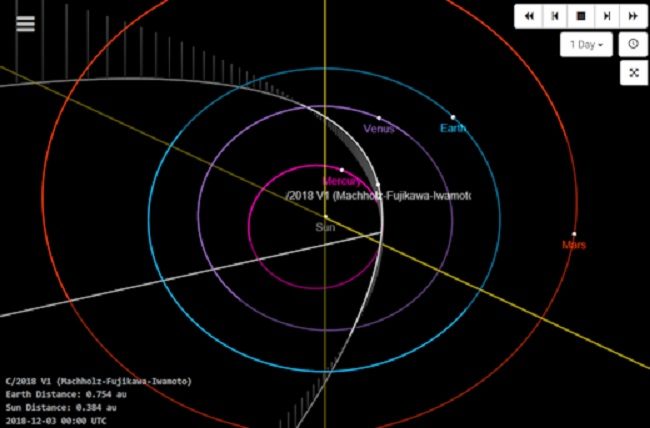
© NASA
CBET 4569 (issued on 2018, November 08) and MPEC 2018-V151 (2018, November 11), announce the discovery of a 10th-magnitude comet by
Donald E. Machholz (Colfax, CA, U.S.A) and independently by Shigehisa Fujikawa (Kan'onji, Kagawa, Japan) and Masayuki Iwamoto(Awa, Tokushima, Japan).
The new comet has been designated C/2018 V1 (Machholz-Fujikawa-Iwamoto).
- D. Machholz reported his VISUAL DISCOVERY on Nov. 7.531 UT with a 0.47-m reflector (113x). He also observed the comet with similar appearance on Nov. 8.533
- Shigehisa Fujikawa found the object (with no description provided) on Nov. 7.82 UT on a CCD image obtained with a 120-mm-f.l. f/3.5 lens. His discovery was reported to the Central Bureau's TOCP webpage, which produced the provisional designation
TCP J12192806-0211143.
- Masayuki Iwamoto discovered the new object on images obtained on Nov. 7.841 with a 10-cm f/4.0 Pentax SDUF II telephoto lens and a Canon EOS 6D camera; Iwamoto called it a possible comet of mag 10 with approximate position R.A. = 12h19m30s, Decl. = -2d11' (equinox 2000.0) and his observations was reported on TCP J12192806-0211143 TOCP webpage. He added that he also observed it one minute later and detected no movement.
Prompted by the Iwamoto's remark in the TOCP webpage about the possible cometary nature of this transient I decided to perform follow-up measurements of this object. The telescope I chose was
T14 astrograph in New Mexico due to its wide field FOV (155.8 x 233.7 arc-mins). In fact as only 1 astrometric position was available at that time and my observation was scheduled 16 hours after it was taken, in case of a comet it was important to have as much field as possible around that only reported astrometry point.
As it happens, it was a comet and I found it about 51 arcmin from the reported astrometry available (60 arcmin is 1 degree). Single unfiltered 60 second exposure, obtained remotely on 2018, November 08.5 from H06 (iTelescope network) through a 0.10-m f/5 reflector + CCD, shows that this object is a comet with a diffuse coma about 2 arcmin in diameter.
My astrometry of this new comet was reported to MPC in order to allow it to be put on "
The Possible Comet Confirmation Page" (TPCCP) for fellow observers around the world to observe it.
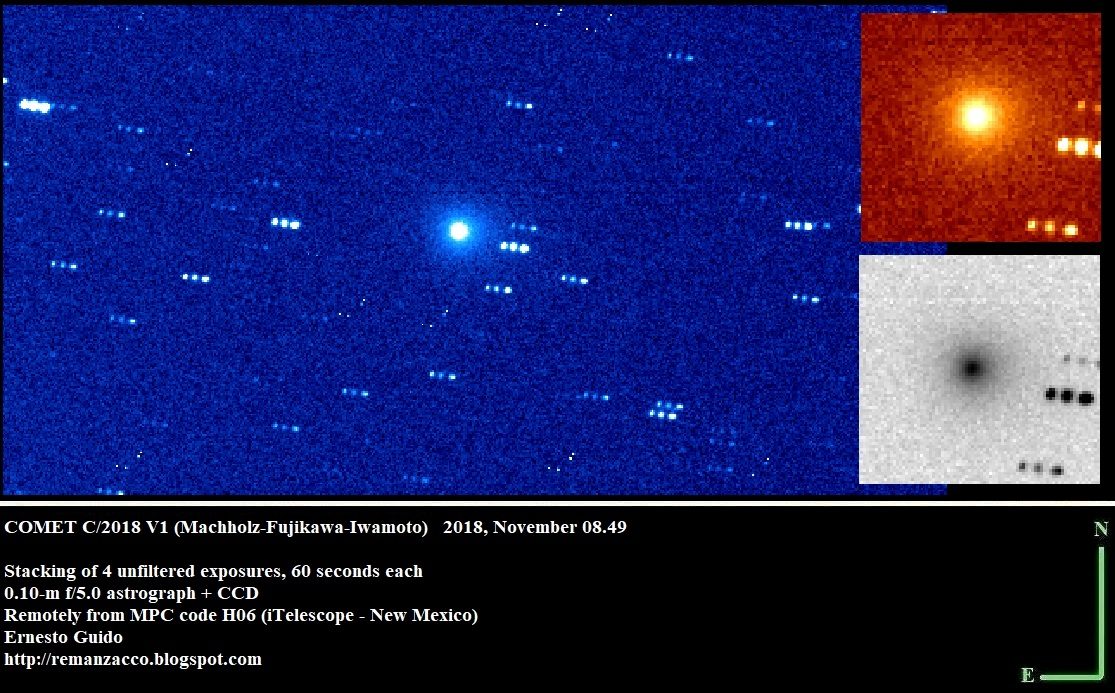
© Remanzacco Blogspot
Below the list of observations in the order they came (following the posting on the TOCP and after that on the Minor Planet Center's NEOCP webpages) as reported on CBET 4569 (click on it for a bigger version):

© NEOCP
Below you can see a short animation spanning about 35 minutes (70 x 30sec exposures) obtained on Nov. 9.16 by fellow Italian amateur astronomer
Alfonso Noschese from his "Osservatorio Elianto" (MPC code K68 - 0.3-m f/4.0 Newtonian reflector + CCD; AstroCampania association). (click on it for a bigger version):
On November 11.16,
A. Noschese imaged again comet C/2018 V1 that in the meantime developed a nice
ion tail clearly visible in his images below:
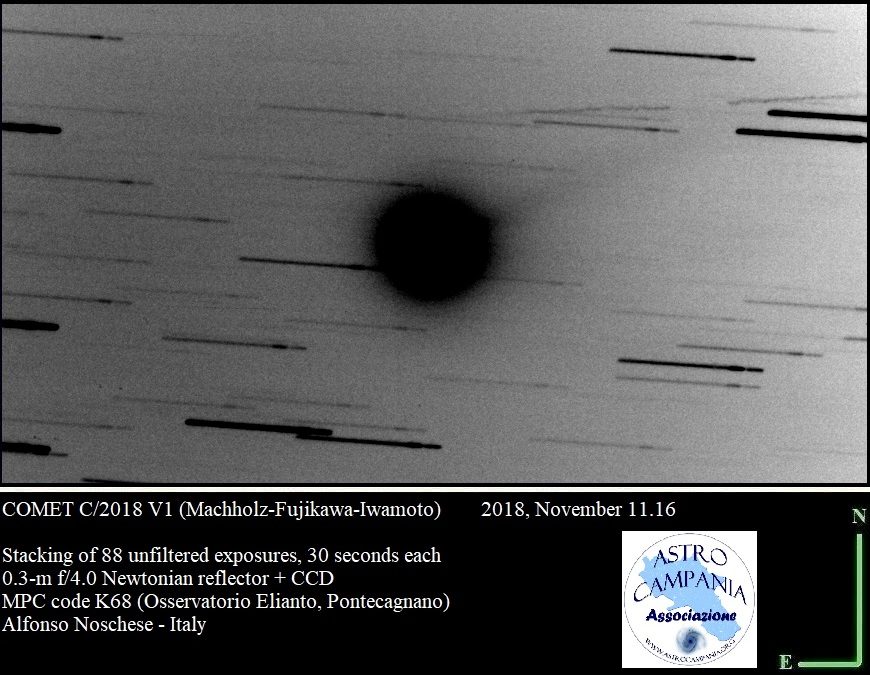
© Remanzacco Blogspot
assigns the following preliminary parabolic orbital elements to comet C/2018 V1: T 2018 Dec. 3.51; e= 1.0; Peri. = 88.83; q = 0.38; Incl.= 143.96
Below you can see a graph generated using the
software Orbitas and showing the predicted magnitude (in red) versus the maximum height (for Northern Hemisphere). (click on the image for a bigger version). Visual estimates have the comet at mag. ~8.0 on November 12, 2018 (as always with comets, the future magnitudes reported here are only indicative).
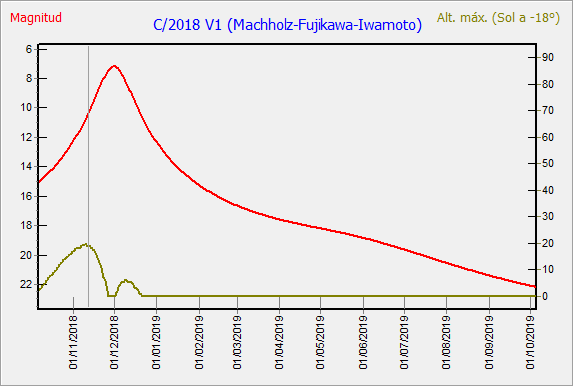
© Orbitas
Congrats to Don Machholz, Shigehisa Fujikawa and Masayuki Iwamoto!
This is 12th comet discovery for Machholz, coming 746 search hours after his discovery of C/2010 F4 (cf. IAUC 9132); the 2nd comet discovery for Iwamoto (see here for more info about his previous discovery C/2013 E2) ; the 7th comet discovery for Fujikawa.
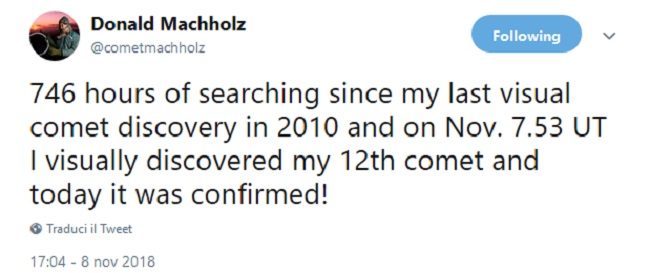
© Twitter
Reader Comments
to our Newsletter